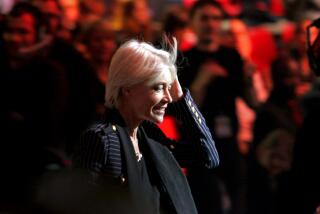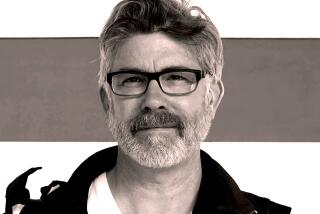Fearless, onstage and in life
Lorraine Hunt Lieberson died often, and exceedingly, devastatingly well. As an opera singer, she was expected to do no less.
But Hunt Lieberson was no ordinary singer. And her deaths onstage were anything but ordinary. They were fantastically fearless. Her dying was not melodramatic, not sentimental, not even tearful, but shattering in a near shamanistic way. And she achieved this by being the most alive singer I have ever witnessed.
Death, she reminded us time and again, was not to be feared, not if you understood it as the thing that makes life meaningful. Come to terms with it and every waking minute matters. In her case, she made every note she sang, and every word, matter to the utmost.
Sunday night, Hunt Lieberson succumbed at age 52, presumably to breast cancer. She kept the details of her illness to herself, not wanting to inject any sentimentality into her work. Her art was not about her but about us, about transcending the ego in music and reaching for universal truths.
But if she demanded we respect her privacy, she also earned that respect by bravely illuminating her enlightened inner life as her own death approached. Physically, she gave little evidence of her condition. It was only in the middle of last month that she canceled the few upcoming appearances she had scheduled, including as soloist at the Los Angeles Philharmonic’s season-opening Mahler Third in September.
Her last performance was in March, in a Chicago Symphony performance of Mahler’s Second Symphony conducted by Michael Tilson Thomas. Among the very last words she sang in public were “I will die, that I might live!” When she sang that two years ago with Tilson Thomas in San Francisco, she was the embodiment of ecstasy.
Transformation was the heart and soul of Hunt Lieberson’s art. She transformed herself from violist to vocalist in her late 20s. She transformed herself from soprano to mezzo soprano. In performance, she abandoned herself to such an astonishing degree that, like a dancer’s, every muscle in her body -- not just her exceptional vocal cords -- seemed directed toward singular, mesmerizing expression. Her voice too was like no other. Her rich, viola tone filled whatever space she was in, wrapping a listener in her singing. She even created that effect once in the Hollywood Bowl, which is an acoustic impossibility.
Some said she was a bit of a nut case. I don’t know what that means, but I think it has something to do with artistic honesty. Too much of it, unflinchingly expressed, is considered weird in this age of artifice and trivial irony.
Was it nutty for her to enact her own death, as she did in two Bach cantatas staged by Peter Sellars five years ago at Lincoln Center in New York? Taken together the cantatas, “My Heart Swims in Blood” and “It Is Enough,” carry a listener through pain, abject suffering and suicidal anguish up to the final acceptance in the awe-inspiring wonder of dying.
Sellars asked the ultimate from Hunt Lieberson. On a bare, black stage, illuminated only by a naked lightbulb held by a dancer, the mezzo, lying on the floor connected to a life-support system, disconnected her tubes as she sang one of the most moving arias in all music and let her soul go.
It was nobody’s business but her own that this was her comeback after more than a year’s absence from performing, during which she nursed a dying sister and underwent treatment for breast cancer. She did not want any of that acknowledged. But when word got out, all she would say was that the performances were, for her, liberating.
A significant lesson in the extraordinary career of Hunt Lieberson was this willingness to be liberated and to put her trust only in those who could effect such liberation. Thus, her career was not conventional. She sang little at the Metropolitan Opera or other major houses and took on few money roles, focusing instead on Handel or French Baroque opera or new works. She worked only with trusted colleagues who were as serious as she was, with singers of the caliber of Dawn Upshaw; with such conductors as Tilson Thomas, Esa-Pekka Salonen, Nicholas McGegan, William Christie and Craig Smith (under whom she played viola at Emmanuel Music in Boston); with the composers John Adams, John Harbison and Peter Lieberson, her husband.
Most important was Sellars. He recognized her potential from the start and put her in his controversial 1985 production of Handel’s “Giulio Cesare,” where her wildness as Ptolemy’s son, Sesto -- she carried an Uzi in this updated version and looked as if she really could use it -- won her instant attention. The opera was both her and Sellars’ breakthrough, and neither looked back. The four Sellars videos in which she can be seen -- the “Cesare,” Mozart’s “Don Giovanni,” Handel’s “Theodora” and Adams’ “El Nino” -- will surely be studied and revered for decades to come.
Hunt Lieberson does leave a substantial legacy on record, including the San Francisco Symphony Mahler Second and the Bach Cantatas. She also leaves a legacy of music written for her, including the role of Kitty Oppenheimer in Adams’ “Doctor Atomic,” which she was not well enough to sing at the San Francisco Opera premiere last fall.
Her final legacy was “Neruda Songs,” her husband’s exceptionally beautiful love letter to her, which the Los Angeles Philharmonic premiered. These are among the most sumptuous orchestral songs ever written, and they are also a profoundly inspiring public farewell by lovers.
It was a small scandal when Lieberson left his first wife and three daughters for the mezzo, after she had appeared in the premiere of his opera, “Ashoka’s Dream,” in Santa Fe in 1997. But now their devotion has entered into musical legend. In the last sonnet of “Neruda Songs,” love, which the poet likens to a long river, denies death, “only changing lands, changing lips.” Hunt Lieberson sang these radiant lines and the hushed radiant music with her own quietly soaring radiance, which is now part of the indelible history of Walt Disney Concert Hall.
Lorraine Hunt Lieberson won’t be missed. She was too important for that. The music she inspired, and I suspect will continue to inspire, is now part of us.
More to Read
The biggest entertainment stories
Get our big stories about Hollywood, film, television, music, arts, culture and more right in your inbox as soon as they publish.
You may occasionally receive promotional content from the Los Angeles Times.











